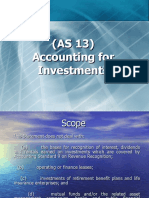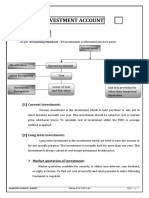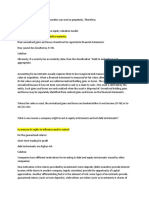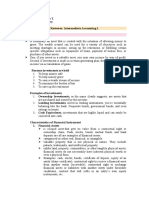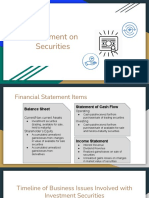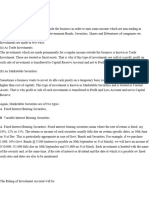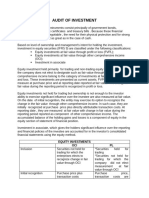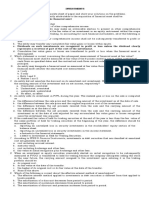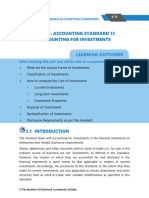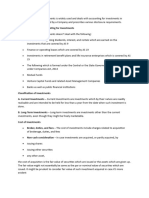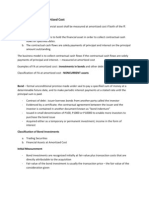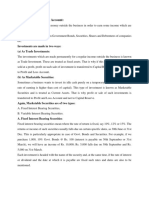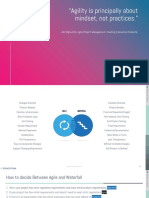Investment Accounts
Investment Accounts
Uploaded by
Mani kandan.GCopyright:
Available Formats
Investment Accounts
Investment Accounts
Uploaded by
Mani kandan.GOriginal Title
Copyright
Available Formats
Share this document
Did you find this document useful?
Is this content inappropriate?
Copyright:
Available Formats
Investment Accounts
Investment Accounts
Uploaded by
Mani kandan.GCopyright:
Available Formats
12
INVESTMENT ACCOUNTS
Learning Objectives
After studying this chapter, you will be able to:
♦ Understand the meaning of the term ‘investments’.
♦ Learn the classification of investments.
♦ Compute the acquisition cost and carrying amounts of investments.
♦ Calculate the profit/loss on disposal of investments.
1. Introduction
Investments are assets held by an enterprise for earning income by way of dividends, interest
and rentals, for capital appreciation, or for other benefits to the investing enterprise.
Investment Accounting is done as per AS-13 which deals with all kind of investments except:
(i) interest, dividends and rentals earned on investments
(ii) operating or financial leases
(iii) investment of retirement benefit plans and life insurance enterprises
(iv) mutual funds
(v) assets held as Stock-in-trade are not ‘Investments’.
2. Classification of Investments
The investments are classified into two categories as per AS 13, viz., Current Investments and
Long-term Investments.
2.1 Current Investments
• A current Investment is an investment that is by its nature readily realizable and
is intended to be held for not more than one year from the date on which such
investment is made.
• The carrying amount for current investments is the lower of cost and fair value.
• Fair Value is the amount for which an asset could be exchanged between a
© The Institute of Chartered Accountants of India
Investment Accounts
knowledgeable, willing buyer and a knowledgeable, willing seller in an arm’s
length transaction. Under appropriate circumstances, market value or net
realisable value provides an evidence of fair value.
• Market Value is the amount obtainable from the sale of an investment in an open
market, net of expenses necessarily to be incurred on or before disposal.
• Any reduction to fair value and any reversals of such reductions are included in
the profit and loss statement.
2.2 Long Term Investments
• A long-term investment is an investment other than a current investment.
• Long term investments are usually carried at cost.
• If there is a permanent decline in the value of a long term investment; the
carrying amount is reduced to recognize the decline.
• The reduction in carrying amount is charged to the profit and loss statement.
• The reduction in carrying amount is reversed when there is a rise in the value of
the investment, or if the reasons for the reduction no longer exist.
3. Investment Acquisitions
1. The cost of an investment includes acquisition charges such as brokerage, fees and duties.
2. If an investment is acquired, or partly acquired, by the issue of shares or other securities,
the acquisition cost is the fair value of the securities or asset issued.
The fair value may not necessarily be equal to the nominal or par value of the securities
issued.
If an investment is acquired in exchange, or part exchange, for another asset, the acquisition
cost of the investment is determined by reference to the fair value of the asset given up. It
may be appropriate to consider the fair value of the investment acquired if it is more clearly
evident.
3. A separate Investment Account should be made for each scrip purchased. The scrips
purchased may be broadly divided into two categories
i) Fixed income bearing scrips
ii) Variable income bearing scrips.
The entries in Investment Account for these two broad categories of scrips will be made as
under:
(i) Fixed income Bearing Securities: The investment in Government securities or
debentures comes under this category. In this type of scrip, the interest accrued from
the date of last payment to the date of transaction can be easily calculated.
12.2
© The Institute of Chartered Accountants of India
Accounting
In case the transaction is on ‘Ex-interest’ basis i.e., the amount of interest accrued to
the date of transaction has to be paid in addition to the price of security.
The following entries are made in the books of Purchaser:
Debit: the amount of price settled as on ex-interest basis is entered in the Capital Column.
Debit: the interest accrued to the date of transaction in the Income Column.
In case the transaction is on cum-interest basis, a part of purchase price is related to
the interest accrued from the date of the last interest paid to the date of transaction.
And hence in this case the cost of investment has to be calculated by subtracting the amount
of accrued interest from the Purchase Price.
The following entries are made in the books of Purchaser:
Debit: the interest accruing from the date of last payment to the date of purchase is entered in
the Income Column.
Debit: balance i.e., Purchase Price - Interest Accrued, in the Capital Column.
When the interest amount is actually received, it is entered in the Income Column credit side.
The net effect of these entries will be that the amount credited to the income will be only the
interest arising between the date of purchase and the one on which it next falls due.
Note:
(a) Interest amount is always calculated with respect to nominal value.
(b) In case the quotation is not qualified, the same will be treated as ex-interest quotation.
(ii) Variable Income Bearing Securities: The investment in equity shares comes
under this category. The following points should be noted with respect to investment
in equity shares:
(a) dividends from investments in shares are not recognised in the statement of
profit and loss until a right to receive payment is established;
(b) the amount of dividend accruing between the date of last dividend payment
and the date of purchase cannot be immediately ascertained;
(c) the dividend received for a particular period of time is assumed to be evenly
distributed over the period.
In the following way the information is incorporated in the books of investor at the time of
purchase:
Debit: The Capital column of the Investment Account by the entire purchase price.
The adjustment with respect to dividend is made when the dividend is actually received as
under:
Credit: The Capital column of the Investment Account by the amount of dividend for the period
for which the investor did not hold the share.
12.3
© The Institute of Chartered Accountants of India
Investment Accounts
Credit: The amount after subtracting the above amount from the total dividends in Income
column of Investment Account.
• The important point with respect to investment in equity shares is that the amount of
dividends for the period, for which the shares were not held by the investor, should not
be treated as revenue receipt but they should be treated as capital receipt.
• When dividends on equity shares are declared from pre-acquisition profits, similar
treatment is done i.e., the amount of such dividend received by the investor is entered
on the credit side in the capital column, so as to reduce the acquisition cost.
• If it is difficult to make an allocation between pre and post acquisition periods except on
an arbitrary basis, the cost of investment is normally reduced by dividends receivable, if
they clearly represent recovery of part of cost.
4. When right shares offered are subscribed for, the cost of the right shares is added to
the carrying amount of the original holding.
If rights are not subscribed for but are sold in the market, the sale proceeds are taken to the
profit and loss statement.
Where the investments are acquired on cum-right basis and the market value of investments
immediately after their becoming ex-right is lower than the cost for which they were acquired,
it may be appropriate to apply the sale proceeds of rights to reduce the carrying amount of
such investments to the market value.
For e.g., Mr. X acquires 200 shares of a company on cum-right basis for ` 50,000. He
subsequently receives an offer of right to acquire fresh shares in the company in the
proportion of 1:1 at ` 110 each. X subscribes for the right issue. Thus, the total cost of X’s
holding of 400 shares would amount to ` 72,000.
Suppose, he does not subscribe but sells the rights for ` 15,000. The ex-right market value of
200 shares bought by X immediately after the rights falls to ` 40,000. In this case out of sale
proceeds of ` 15,000, ` 10,000 may be applied to reduce the carrying amount to the market
value ` 40,000 and ` 5,000 would be credited to the profit and loss account.
5. Where an investment is acquired by way of issue of bonus shares, no amount is entered
in the capital column of investment account since the investor has not to pay anything.
4. Disposal of Investments
• On disposal of an investment, the difference between the carrying amount and the
disposal proceeds, net of expenses is recognised in the profit and loss statement.
• When a part of the holding of an individual investment is disposed, the carrying amount
is required to be allocated to that part on the basis of the average carrying amount of
the total holding of the investment.
• In respect of shares, debentures and other securities held as stock-in-trade, the cost of
stocks disposed of may be determined by applying an appropriate cost formula (e.g.
12.4
© The Institute of Chartered Accountants of India
Accounting
first-in, first-out, average cost, etc.). These cost formulae are the same as those
specified in AS 2, ‘Valuation of Inventories’.
(i) Fixed Income Bearing Securities: The amount of accrued interest from the date of last
payment to the date of sale is credited in the income column and only the sale proceeds, net
of accrued interest, is credited in the capital column of investment account.
In case the transaction is on ‘Ex-interest’ basis, entire sale proceeds is credited in the capital
column and the amount of accrued interest from the date of last payment to the date of sale,
separately received from the buyer will be taken to the credit side of the income column of
investment account.
(ii) Variable Income Bearing Securities: In case of these securities, the entire amount of
sale proceeds should be credited in the capital column of investment account, unless the
amount of accrued dividend can be specifically established.
The entries in the books at the time of sale of investments will be just the reverse of the
entries passed for their acquisition.
Illustration 1
On 1.4.2010, Sundar had 25,000 equity shares of ‘X’ Ltd. at a book value of ` 15 per share
(Face value ` 10). On 20.6.2010, he purchased another 5,000 shares of the company at ` 16
per share. The directors of ‘X’ Ltd. announced a bonus and rights issue. No dividend was
payable on these issues. The terms of the issue are as follows:
Bonus basis 1:6 (Date 16.8.2010).
Rights basis 3:7 (Date 31.8.2010) Price ` 15 per share.
Due date for payment 30.9.2010.
Shareholders can transfer their rights in full or in part. Accordingly Sundar sold 33.33% of his
entitlement to Sekhar for a consideration of ` 2 per share.
Dividends: Dividends for the year ended 31.3.2010 at the rate of 20% were declared by X Ltd.
and received by Sundar on 31.10.2010. Dividends for shares acquired by him on 20.6.2010
are to be adjusted against the cost of purchase.
On 15.11.2010, Sundar sold 25,000 equity shares at a premium of ` 5 per share.
You are required to prepare in the books of Sundar.
(1) Investment Account
(2) Profit & Loss Account.
For your exercise, assume that the books are closed on 31.12.2010 and shares are valued at
average cost.
12.5
© The Institute of Chartered Accountants of India
Investment Accounts
Solution
Books of Sundar
Investment Account
Equity Shares in X Ltd.
No. Amount No. Amount
` `
1.4.2010 To Bal 25,000 3,75,000 30.9.2010 By Bank 10,000
b/d (Sale of
Rights)
20.6.2010 To Bank 5,000 80,000 31.10.2010 By Bank 10,000
(dividend
16.8.2010 To 5,000 — on shares
Bonus acquired on
20/6/2010)
30.9.2010 To Bank 10,000 15.11.2010 By Bank 25,000 3,75,000
(Rights 1,50,000 (Sale of
Shares) shares)
15.11.2010 To Profit 50,000 31.12.2010 By Bal. c/d 20,000 2,60,000
45,000 6,55,000 45,000 6,55,000
Profit & Loss A/c
To Balance c/d 1,00,000 By Profit transferred 50,000
By Dividend 50,000
1,00,000 1,00,000
Working Notes:
(1) Bonus Shares =
(25,000 + 5,000)
5,000 shares
6
25,000 + 5,000 + 5,000
(2) Right Shares = × 3 = 15,000 shares
7
(3) Rights shares renounced = 15,000×1/3 = 5,000 shares
(4) Dividend received = 25,000×10×20% = ` 50,000
Dividend on shares purchased on 20.6.2010 = 5,000×10×20% = ` 10,000 is adjusted to
Investment A/c
(5) Cost of shares on 31.12.2010
( 3,75,000 + 80,000 + 1,50,000 − 10,000 − 10,000 ) × 20,000 = ` 2,60,000
45,000
Illustration 2
On 1.4.2010, Mr. Krishna Murty purchased 1,000 equity shares of ` 100 each in TELCO Ltd.
12.6
© The Institute of Chartered Accountants of India
Accounting
@ ` 120 each from a Broker, who charged 2% brokerage. He incurred 50 paise per ` 100
as cost of shares transfer stamps. On 31.1.2011 Bonus was declared in the ratio of 1 : 2.
Before and after the record date of bonus shares, the shares were quoted at ` 175 per share
and ` 90 per share respectively. On 31.3.2011 Mr. Krishna Murty sold bonus shares to a
Broker, who charged 2% brokerage.
Show the Investment Account in the books of Mr. Krishna Murty, who held the shares as
Current assets and closing value of investments shall be made at Cost or Market value
whichever is lower.
Solution
In the books of Mr. Krishna Investment Account
for the year ended 31st March, 2011
(Scrip: Equity Shares of TELCO Ltd.)
Dr. Cr.
Date Particulars Nominal Cost Date Particulars Nominal Cost
Value (` (` ) Value (` ) (` )
)
1.4.2010 To Bank A/c 1,00,000 1,23,000 31.3.2011 By Bank A/c 50,000 44,100
31.1.2011 To Bonus 50,000 − 31.3.2011 By Balance 1,00,000 82,000
shares c/d
31.3.2011 To Profit &
loss A/c − 3,100
1,50,000 1,26,100 1,50,000 1,26,10
0
Working Notes:
(i) Cost of equity shares purchased on 1.4.2010 = 1,000 × ` 120 + 2% of ` 1,20,000 +
½% of ` 1,20,000 = ` 1,23,000
(ii) Sale proceeds of equity shares sold on 31st March, 2011 = 500 × ` 90 – 2% of `
45,000 = ` 44,100.
(iii) Profit on sale of bonus shares on 31st March, 2011
= Sales proceeds – Average cost
Sales proceeds = ` 44,100
Average cost = ` (1,23,000 × 50,000)/1,50,000 = ` 41,000
Profit = ` 44,100 – ` 41,000 = ` 3,100.
(iv) Valuation of equity shares on 31st March, 2011
Cost = (` 1,23,000 × 1,00,000)/1,50,000 = ` 82,000)
Market Value = 1,000 shares × ` 90 = ` 90,000
Closing balance has been valued at ` 82,000 being lower than the market value.
12.7
© The Institute of Chartered Accountants of India
Investment Accounts
Illustration 3
Mr. X purchased 500 equity shares of ` 100 each in Omega Co. Ltd. for ` 62,500 inclusive of
brokerage and stamp duty. Some years later the company resolved to capitalize its profits and
to issue to the holders of equity shares, one equity bonus share for every share held by them.
Prior to capitalisation, the shares of Omega Co. Ltd. were quoted at ` 175 per share. After the
capitalisation, the shares were quoted at ` 92.50 per share. Mr. X. sold the bonus shares and
received at ` 90 per share.
Prepare the Investment Account in X’s books on average cost basis.
Investment Account in the books of A
[Equity shares in Omega Co. Ltd.]
Nominal Value Cost Nominal Value Cost
` ` ` `
To Cash 50,000 62,500 By Cash Sale 50,000 45,000
To Bonus shares 50,000 By Balance c/d 50,000 31,250
To P & L A/c 13,750
1,00,000 76,250 1,00,000 76,250
To Balance b/d 50,000 31,250
Note : The total cost of 1,000 share including bonus is ` 62,500
500
Therefore, cost of 500 shares (carried forward) is × 62,500 = ` 31,250
1,000
Cost being lower than the market price, shares are carried forward at cost.
Illustration 4
On 1st January 2010, Singh had 20,000 equity shares in X Ltd. Face value of the shares was
` 10 each but their book value was ` 16 per share. On 1st June 2010, Singh purchased
5,000 more equity shares in the company at a premium of ` 4 per share.
On 30th June, 2010, the directors of X Ltd. announced a bonus and rights issue. Bonus was
declared at the rate of one equity share for every five shares held and these shares were
received on 2nd August, 2010.
The terms of the rights issue were:
(a) Rights shares to be issued to the existing holders on 10th August, 2010.
(b) Rights issue would entitle the holders to subscribe to additional equity shares in the
Company at the rate of one share per every three held at ` 15 per share-the whole sum
being payable by 30th September, 2010.
(c) Existing shareholders may, to the extent of their entitlement, either wholly in part, transfer
their rights to outsiders.
(d) Singh exercised his option under the issue for 50% of his entitlements and the balance of
rights he sold to Ananth for a consideration of ` 1.50 per share.
12.8
© The Institute of Chartered Accountants of India
Accounting
(e) Dividends for the year ended 31st March, 2010, at the rate of 15% were declared by the
Company and received by Singh on 20th October, 2010.
(f) On 1st November, 2010, Singh sold 20,000 equity shares at a premium of ` 3 per share.
The market price of share on 31-12-2010 was ` 13. Show the Investment Account as it would
appear in Singh’s books on 31-12-2010 and the value of shares held on that date.
Solution
Investment Account-Equity Shares in X Ltd.
Date No. of Income Amount Date No. of Income Amount
shares shares
` ` ` `
2010 2010
Jan. To 20,000 - 3,20,000 Sep. By Bank 7,500
1 Balance 30 (Sale of
b/d rights)
5,000 @
` 1.5
June To Bank 5,000 - 70,000 Oct. 20 By Bank 30,000 7,500
1 (dividend)
Aug. To Bonus 5,000 — Nov. 1 By Bank 20,000 2,60,000
2 Issue
Sep. To Bank 5,000 - 75,000 Dec. By 15,000 1,92,857
30 (Right) 31 Balance
c/d
Nov. To Profit - - 2,857
1 & Loss
A/c (Profit
on sale)
Nov. To Profit 30,000
1 & Loss
A/c
(Dividend
income)
35,000 30,000 4,67,857 35,000 30,000 4,67,857
Jan. To 15,000 1,92,857
1 Balance
b/d
Working Notes:
1. Cost of shares sold — Amount paid for 35,000 shares
`
(` 3,20,000 + ` 70,000 + ` 75,000) 4,65,000
Less: Dividend on shares purchased on June 1 & sale of rights(7,500 + 7,500) 15,000
Cost of 35,000 shares 4,50,000
12.9
© The Institute of Chartered Accountants of India
Investment Accounts
Cost of 20,000 shares (Average cost basis) 2,57,143
Sale proceeds 2,60,000
Profit 2,857
2. Value of investment at the end of the year
Assuming investment as current investment, closing balance will be valued based on
lower of cost or net realizable value.
Here, Net realizable value is ` 13 per share i.e. 15,000 shares x ` 13= ` 1,95,000 and
4,50,000
cost = × 15,000 = ` 1,92,857. Therefore, value of investment at the end of the
35,000
year will be ` 1,92,857.
5. Valuation in case of Reclassification of Investment
When Investments are classified from Current Investment to Permanent Investment,
Permanent Investment is valued at Cost Price or Fair Value, whichever is less.
When Investments are classified from Permanent Investment to Current Investment, Current
Investment is valued at Cost Price or Carrying Amount, whichever is less.
Summary
• Investment Accounting is done as per Accounting Standard-13.
• Two type of Investments :
9 Long Term Investments
9 Current Investments
• Valuation of Current investment – Lower of Cost or Fair Value/net Realizable Value
• Valuation of Long Term investment – At cost
• Reclassification :
9 From Current to Permanent → Valuation at Cost or Fair value, whichever is lower
9 From Permanent to Current → Valuation at Cost or Carrying Amount, whichever is
lower
• Disposal of Investment:
9 Difference between carrying amount and disposal proceeds is transferred to Profit &
Loss A/c.
In case of partial sale, weighted average method to be used.
12.10
© The Institute of Chartered Accountants of India
You might also like
- Intermediate Accounting 2: a QuickStudy Digital Reference GuideFrom EverandIntermediate Accounting 2: a QuickStudy Digital Reference GuideNo ratings yet
- CH11Document56 pagesCH11Daniel BermanNo ratings yet
- Financial Decision PDFDocument72 pagesFinancial Decision PDFDimple Pankaj Desai100% (1)
- Osh Rules For Outsourced ProvidersDocument10 pagesOsh Rules For Outsourced ProvidersrobinrubinaNo ratings yet
- Unit-6 Investment AccountingDocument37 pagesUnit-6 Investment Accountingkawanalavesh4No ratings yet
- As 13 - Investment AccountsDocument6 pagesAs 13 - Investment AccountsJiya Mary JamesNo ratings yet
- Accounting For InvestmentsDocument17 pagesAccounting For InvestmentsPradeep Gupta100% (1)
- CA Sanket Shah Investment Accounts 1648218684Document5 pagesCA Sanket Shah Investment Accounts 1648218684workspaceconsultancy24x7No ratings yet
- MATERIALDocument8 pagesMATERIALVatsal ParmarNo ratings yet
- 10 AS13 Invesment AccountingDocument8 pages10 AS13 Invesment Accountingprashantmis452No ratings yet
- As 13Document12 pagesAs 13Noorul Zaman KhanNo ratings yet
- 7 As 13 Accounting For InvestmentsDocument32 pages7 As 13 Accounting For Investmentscloudstorage567No ratings yet
- Financial Accounting and Reporting - InvestmentsDocument10 pagesFinancial Accounting and Reporting - InvestmentsLuisitoNo ratings yet
- Accounting For InvestmentsDocument6 pagesAccounting For InvestmentsBeldineNo ratings yet
- Week 05 - 02 - Module 11 - Investment in Equity InstrumentsDocument10 pagesWeek 05 - 02 - Module 11 - Investment in Equity Instruments지마리No ratings yet
- As 13Document15 pagesAs 13dilipupadhyay1979No ratings yet
- Exam NotesDocument9 pagesExam NotesEven JayNo ratings yet
- Investments and AcquisitionsDocument5 pagesInvestments and AcquisitionsBurhan Al MessiNo ratings yet
- As 13Document6 pagesAs 13abhishekkapse654No ratings yet
- E-Books - AS 13 Accounting For InvestmentsDocument32 pagesE-Books - AS 13 Accounting For InvestmentssmartshivenduNo ratings yet
- Indas 27 Separate Financial Statements: Detailed Overview of The StandardDocument38 pagesIndas 27 Separate Financial Statements: Detailed Overview of The Standardyashmittal0712No ratings yet
- Investment Accounting W.R.T. As-13Document4 pagesInvestment Accounting W.R.T. As-13navin_khubchandaniNo ratings yet
- Fa - Investment in Equity Securities - Lecture NotesDocument4 pagesFa - Investment in Equity Securities - Lecture NotesCharlene Jane EspinoNo ratings yet
- As 13Document11 pagesAs 13Avinash YadavNo ratings yet
- Chapter 9Document18 pagesChapter 9Rubén ZúñigaNo ratings yet
- Financial Accounting - Investment AccountDocument5 pagesFinancial Accounting - Investment AccountsmlingwaNo ratings yet
- Continued: College Retirement Equities Fund 2019 Annual Report 113Document1 pageContinued: College Retirement Equities Fund 2019 Annual Report 113Ljubisa MaticNo ratings yet
- Reviewer - IntaccDocument36 pagesReviewer - IntaccPixie CanaveralNo ratings yet
- FA To Investment Property-DiscussionDocument7 pagesFA To Investment Property-DiscussionMary Rose Castillo AguadoNo ratings yet
- Accounting For InvestmentsDocument9 pagesAccounting For InvestmentsJacy VykeNo ratings yet
- Module 1 Notes For Intermediate AccountingDocument2 pagesModule 1 Notes For Intermediate Accountingpineda.keesha414No ratings yet
- Financial Assets at Fair Value NotesDocument3 pagesFinancial Assets at Fair Value NotesJames R JunioNo ratings yet
- Audit of Investment-LectureDocument15 pagesAudit of Investment-LecturemoNo ratings yet
- Investment On SecuritiesDocument22 pagesInvestment On SecuritiesXiu MinNo ratings yet
- Treasury ManagementDocument28 pagesTreasury ManagementmarifeNo ratings yet
- Acf 202-F.aDocument18 pagesAcf 202-F.aAlor ChideraNo ratings yet
- Investment - NotesDocument15 pagesInvestment - Notesbelladump02No ratings yet
- InvestmentsDocument2 pagesInvestmentsAlora EuNo ratings yet
- Unit 6: Long-Term InvestmentsDocument40 pagesUnit 6: Long-Term Investmentssamuel kebedeNo ratings yet
- Acf 202-F.a.Document6 pagesAcf 202-F.a.Alor ChideraNo ratings yet
- 5418 Assignment # 01Document24 pages5418 Assignment # 01noorislamkhanNo ratings yet
- Mutual Funds and Venture Capital Funds And/or The Related Asset Management Companies, Banks and Public Financial InstitutionsDocument14 pagesMutual Funds and Venture Capital Funds And/or The Related Asset Management Companies, Banks and Public Financial InstitutionsrazorNo ratings yet
- 74697bos60485 Inter p1 cp5 U3Document35 pages74697bos60485 Inter p1 cp5 U3aryanharsh2004No ratings yet
- De Guzman, C. - ACCTG 025 Audit of Stockholder's Equity, Share Based Payment & Book Value and Earnings Per ShareDocument6 pagesDe Guzman, C. - ACCTG 025 Audit of Stockholder's Equity, Share Based Payment & Book Value and Earnings Per ShareJessalyn DaneNo ratings yet
- Chapter 4 Investments in Equity SecuritiesDocument25 pagesChapter 4 Investments in Equity SecuritiesCarylle silveoNo ratings yet
- Questionnaire IntactDocument10 pagesQuestionnaire Intact?????No ratings yet
- FAR 4307 Investment in Equity SecuritiesDocument3 pagesFAR 4307 Investment in Equity SecuritiesATHALIAH LUNA MERCADEJASNo ratings yet
- B. Com 5 Sem Advance Financial Accounting 1Document9 pagesB. Com 5 Sem Advance Financial Accounting 1AlankritaNo ratings yet
- Investment MangementDocument44 pagesInvestment MangementDivya SindheyNo ratings yet
- Finance. Lecture 04Document6 pagesFinance. Lecture 04Leire Garcia ZabalaNo ratings yet
- Chapter 4 Financing Decisions PDFDocument72 pagesChapter 4 Financing Decisions PDFChandra Bhatta100% (1)
- AS 13 Accounting For Investments 1Document2 pagesAS 13 Accounting For Investments 1thre333eNo ratings yet
- Financial Assets at Amortized CostDocument8 pagesFinancial Assets at Amortized CostbluemajaNo ratings yet
- Investment in Equity Securities - IA1Document17 pagesInvestment in Equity Securities - IA1dumpyforhimNo ratings yet
- UNIT 2 Cost of CapitalDocument11 pagesUNIT 2 Cost of Capitalshreya.fruity23No ratings yet
- FAR-4207 (Investment in Equity Securities)Document3 pagesFAR-4207 (Investment in Equity Securities)Jhonmel Christian AmoNo ratings yet
- Financial Management Unit 2Document10 pagesFinancial Management Unit 2Janardhan VNo ratings yet
- What Are The Characteristics of A Bond Investment? AnswerDocument4 pagesWhat Are The Characteristics of A Bond Investment? AnswerAllysa Jane FajilagmagoNo ratings yet
- Mutual FundDocument10 pagesMutual FundmadhuNo ratings yet
- Investment New ScopeDocument19 pagesInvestment New ScopeayinaNo ratings yet
- Week 5 Introduction To InvestmentDocument19 pagesWeek 5 Introduction To Investmentjane caranguianNo ratings yet
- عملي دوائر اليوم2Document24 pagesعملي دوائر اليوم2معاً إلى الجنةNo ratings yet
- GPN - TsurumiDocument4 pagesGPN - TsurumiedfabaroNo ratings yet
- Normalization New 1Document60 pagesNormalization New 1Shivanshi SinghNo ratings yet
- Internet Access MethodsDocument4 pagesInternet Access Methodsdrgnarayanan100% (1)
- 0X. - Agile Project Management - OUTDocument13 pages0X. - Agile Project Management - OUTNanang ZarmaNo ratings yet
- Defense Motion To Dismiss CaseDocument44 pagesDefense Motion To Dismiss CaseavertebrateNo ratings yet
- 48 Garcia v. Robles Vda. de CaparasDocument3 pages48 Garcia v. Robles Vda. de CaparasKatrina Janine Cabanos-ArceloNo ratings yet
- The X-Rite Color Challenge and Hue TestDocument7 pagesThe X-Rite Color Challenge and Hue TestJudson ChristudasNo ratings yet
- China Jiangxi Hongda MedicalDocument1 pageChina Jiangxi Hongda MedicalUzair Ul GhaniNo ratings yet
- SDS Westpac Ready Mix CompoundsDocument8 pagesSDS Westpac Ready Mix CompoundsSherif ShahinNo ratings yet
- T.2.1 Column Calculations: The Columns Are Modelled As EitherDocument16 pagesT.2.1 Column Calculations: The Columns Are Modelled As Eithertailieuxaydung2019No ratings yet
- TLE2061 PrecisionDocument82 pagesTLE2061 PrecisionvelizarkoNo ratings yet
- Ari PremioDocument0 pagesAri PremioCandiano PopescuNo ratings yet
- HURCO 3 Axis0118Document20 pagesHURCO 3 Axis0118misterdo53No ratings yet
- Digital Image Processing (Image Enhancement)Document45 pagesDigital Image Processing (Image Enhancement)MATHANKUMAR.S100% (2)
- Cool Powerpoint TemplateDocument15 pagesCool Powerpoint TemplatekotonleexNo ratings yet
- Marketing Plan - Bread DelightDocument22 pagesMarketing Plan - Bread DelightStefan GonzalesNo ratings yet
- Value Chain Management Project Due Date: On The Final Exam DateDocument4 pagesValue Chain Management Project Due Date: On The Final Exam Dateminale destaNo ratings yet
- Value AddedDocument15 pagesValue AddedDoku Doku100% (1)
- Harf Project PortfolioDocument11 pagesHarf Project Portfolioapi-525092858No ratings yet
- 10-6.Self-Diagnosis by Remote Controller (Check Code)Document3 pages10-6.Self-Diagnosis by Remote Controller (Check Code)AriesNo ratings yet
- Iot Based Intelligent Medicine BoxDocument6 pagesIot Based Intelligent Medicine BoxAkshay PatilNo ratings yet
- Hensi N. PoriyaDocument61 pagesHensi N. PoriyaRaj KumarNo ratings yet
- SPM Kelompok 1Document33 pagesSPM Kelompok 1Septiani PrayudiNo ratings yet
- Perforation Varieties Can Make The DifferenceDocument4 pagesPerforation Varieties Can Make The DifferenceSabah SalihNo ratings yet
- Miriam College Gile Recommendation Form Feb2020-1Document1 pageMiriam College Gile Recommendation Form Feb2020-1Karen Heidi GileNo ratings yet
- Civil EngineerDocument18 pagesCivil EngineerNazmus SakibNo ratings yet
- Particle Tracing Module: Introduction ToDocument40 pagesParticle Tracing Module: Introduction ToAlfonso BarbozaNo ratings yet
- Biology Notes Unit TwoDocument158 pagesBiology Notes Unit TwoBlohsh KeenenNo ratings yet






